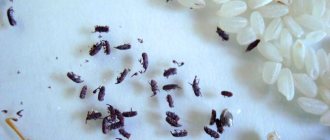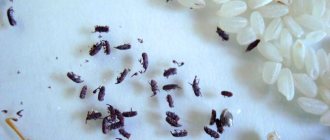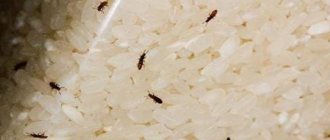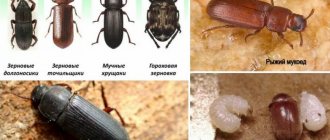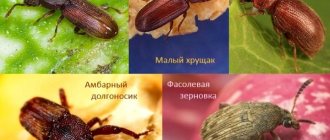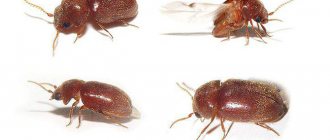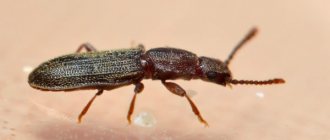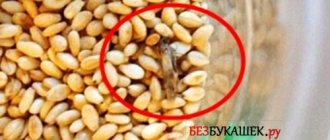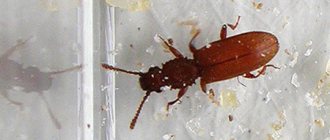Why can bugs appear in flour or cereals?
Beetles appear in cereals or flour, as well as in nuts, dried fruits, beans, peas and even tea, not because of the untidiness of the housewife or uncleanliness in the kitchen cabinet, if they were not there before. Bugs appear from outside.
From a pack bought in a store, from cereal taken from a neighbor or relatives, from dried fruits brought as a treat that were already infested with bugs.
This photo shows that the bugs that are in the cereal are not always easy to see!
Why do cereals get bugs? The reason is unscrupulous checks at enterprises when packing cereals and flour, and poor initial processing of grain. Grain must be processed in a special way before becoming cereal in order to exclude the possibility of the presence of living organisms and their larvae in it.
Another reason is the poor quality of work of the control bodies monitoring the quality of products. Any low-quality, contaminated batch of cereal or flour must be rejected and not allowed for sale.
Otherwise, bugs appear in flour or cereals, and people have to think about how to get rid of them.
How do bugs appear in stores?
- The products were already delivered with beetles from the suppliers' warehouses.
- They have already appeared in the supermarket due to dry air and unsanitary conditions.
So:
- Can't tolerate beetles.
- Bright sunlight.
- Dry air.
- Smells of garlic, cloves, bay leaves.
- Steel materials such as nails or coins.
- Clean and tidy owners.
- High or low temperature.
Need to:
- Carefully select bulk products in stores and markets.
- Keep kitchen cabinets in order.
- Ventilate the premises as often as possible.
- Monitor the condition of the furniture so that no cracks form in it.
What insects can live in cereals and flour?
What to do if there are bugs in cereals or flour? To know how to get rid of bugs in cereals and flour, you need to know who exactly you need to fight.
Most often, flour beetles and food moths are found in cereals and flour.
The Surinam mucoedis is an insect of the order Coleoptera, a brown pest. It lives in granaries, mills, shops, houses and apartments.
In its development, the mucoed goes through several stages: egg, larva, pupa, and adult. The larva is very small in size - no more than 0.9 mm, so it is very difficult to detect. The mukoed lives from 0.5 to 3 years, laying up to 600 eggs.
Under favorable conditions (air temperature 25-27 degrees and humidity about 65%), the insect reproduces 2-3 times faster than at lower temperatures and humidity.
The Indian food moth is a small butterfly, up to 1 cm long. It lives only 2-3 weeks, but during this time it manages to lay up to 400 eggs, which then become caterpillars. The latter spoil the food by eating everything that is nearby.
After a few weeks, the grown larvae become pupae, and these, in turn, become adult butterflies, ready to produce new offspring.
Both flour eaters and moths are very tenacious, even in frost they do not die immediately. This must be taken into account in order to understand how to get rid of bugs in flour and cereals.
The photo below shows another type of bug that can be found in cereals or flour in your kitchen - this is the flour beetle:
Is it possible to eat cereals or flour if there are bugs in it?
One of the most common questions that arises among people who encounter insects in the kitchen: if there are bugs in the cereal, can it be eaten? Seeing that there are insects in cereals or flour, it is unlikely that anyone will want to eat them. But if we ignore the psychological component, is it possible to sort out the cereal, wash it and be sure that there are no bugs?
The answer to this question is negative. The fact is that even if you sort through the cereal and remove all the bugs, the larvae may simply not be noticed. They are small and have an inconspicuous color.
In addition, the cereal contains waste products of bugs, caterpillars and larvae: feces, dead larvae, husks that remain during degeneration into a pupa or butterfly.
The situation is somewhat different with flour. It can be sifted into a fine sieve, through which neither larvae nor debris left by bugs will pass. This is one way to get rid of bugs in flour.
After this operation, it is recommended to heat the sifted flour in the oven at 50 degrees.
Causes of flour bugs
The most common reason is non-compliance with technological and sanitary standards during food production. Therefore, no one is immune from such a nuisance.
Initially, insects enter the house with dry food, and then quickly spread throughout the kitchen. Pests colonize near food, but are found in cracks, latches and other hidden places.
This is interesting: most insects are so small that they are difficult to notice with the naked eye. They camouflage themselves with the color and shape of the environment in which they live.
In everyday life, bugs appear in cereals or other products if:
- Containers for storing bulk solids are selected incorrectly. Preference should be given to glass and plastic containers with fully screw-on lids or a vacuum effect. An inexpensive alternative is to use plastic bags that must be tied. Limited contact with air and dampness allows you to preserve food longer and prevent insects from accessing it.
- The expiration date has expired. All food products have a specific shelf life. Information about this is indicated on the packaging. Goods sold by weight are fraught with danger, since the actual date of their production and sorting cannot be determined.
- Conditions of detention are not met. A warm, damp atmosphere in a closet or indoors, if we are talking about a pantry, is a favorable factor for the intensive reproduction of cereal bugs. In this regard, air temperature and humidity play an important role when choosing a place to store bulk products.
Advice: it is recommended not to make large reserves unless absolutely necessary, but to limit yourself to moderate volumes and look into the bins more often.
Pest insects like to nest in:
- various cereals;
- pasta;
- flour;
- loose leaf tea;
- granulated or ground coffee;
- dried fruits;
- spices
In order to promptly notice the presence of an “inedible impurity” in a product, you need to know what exactly to look for, that is, what the bugs look like.
Important: the main danger lies not even in food spoilage, but in the allergic reaction or food poisoning that they can provoke.
How to get rid of insects in cereals and flour
Before you completely remove the bugs that have infested in cereals and cupboards, you need to throw away all the cereals in which they were found. Some people cook this cereal and feed it to backyard birds, which are not afraid of bugs; this is their daily food.
You cannot limit yourself to simply getting rid of contaminated products. After all, larvae can be on packages with other products that were lying nearby, on doors, and in the corners of cabinets.
The next thing you should definitely do when fighting bugs is to wash the cabinet with detergent and then treat it with vinegar. Banks in which spoiled cereals were stored must also be processed.
Prevention of insects in flour and cereals
In order not to think about how to remove bugs from cereals or flour, you can take some measures that will prevent them from appearing and multiplying.
Pests cannot tolerate strong odors. Therefore, garlic, bay leaves, and cloves placed in cabinets will help prevent the appearance of bugs.
Another good way to keep flour and cereals from bugs is to store these products in glass, metal or plastic containers with tight-fitting lids.
General cleaning as a method of pest control
Pests can also be removed by thoroughly cleaning their habitat. But subject to the obligatory condition of disposal of affected products.
What do we have to do:
- Empty the cabinet or shelf of its contents. Clean everything inside with a soapy vinegar solution. Pay special attention to food residues that often spill out in storage areas.
- Pour boiling water over all containers.
- Wash fabric bags in salt water.
- For adult individuals, it is better to use special traps.
Plants with a pungent odor also show good results in the fight against insects. These include mint, lavender, lemon balm and others. Soaking cloth strips in extracts will help prevent a new insect infestation. The main thing is not to forget to update your feeds.
Why do bugs appear in cereals?
Many people believe that kitchen pests arise only as a result of gross violations of sanitation and hygiene standards. Unfortunately, it is not. Flour bugs can live in your food, even if you regularly do thorough wet cleaning. The main reason for the appearance of parasites is non-compliance with control standards at food production enterprises. Some manufacturers ignore even such a mandatory procedure as heat treatment, not to mention high storage standards.
You can detect black bugs in cereals even if you purchased the product in vacuum packaging. Insects usually have plenty of time to “invade” while the product is awaiting packaging. Bugs in the kitchen do not limit their stay to one “house”. They quickly and willingly master new nutrient environments, while not forgetting about future generations. Parasites reproduce very quickly and fruitfully. The answer to the question of how to get rid of insects in cereals and in the cupboard will be incomplete if it does not contain information on how to find and destroy egg-laying insects. And they can be located almost anywhere, including the most inconspicuous crevices in furniture. Fortunately, this problem can usually be dealt with without the help of strong chemicals.
If there are bugs in the flour, can it be used?
Many thrifty owners are interested in what to do if there are bugs in the rice. Is it possible to eat it or is it better to immediately throw it away out of harm’s way? Ideally, spoiled products should be disposed of. Elementary disgust has not yet been abolished, in addition, even a mass thoroughly cleaned of adult individuals may contain the remnants of their vital activity. It’s not enough to get the beetles out of the grains; you also need to be sure that the cleaning was perfect. Even if you calmly accept the fact that parasites are in your food, this will not save you in case of poisoning. The consequences may be the most tragic.
If you are thinking about how to get rid of bugs in the kitchen and at the same time do not want to throw away spoiled food entirely, the processing should be as thorough as possible. In the case of flour, you will need a sieve with the smallest mesh possible. Not only adults should remain on the grill, but also the larvae and debris they produce. However, it is not enough to simply remove insects in flour in the kitchen. To gain complete confidence in the safety of purified food, it must be subjected to thorough heat treatment. There are two ways to influence insects with temperature. You can finally get rid of the flour bug by placing the sifted mixture in the oven. Drying at a temperature of fifty degrees will not leave any chance for harmful residues. Another option is to freeze. A day in the freezer will also destroy all germs.
What to do if insects are found in cereals? How to get rid of them without throwing away the entire product. In such situations, the cleaning process is even easier. Simply pour salt water over the rice, beans or beans and leave for a few minutes. After some time, all the bugs in the cereal will separate from the main mass and float up, as well as their derivatives. After this, all that remains is to carefully drain the water and dry everything on a clean cloth. Once you get rid of flour bugs, use the products as soon as possible. Some of the taste will be lost, but the nutritional properties will remain at an acceptable level.
Restorative actions make sense only when only a small part of the main mass is affected. If insects in cereals or flour have left behind an impressive “web” of yellow worms, you should come to terms with the loss and do everything to ensure that a similar situation does not happen again. Spoiled food should be thrown away along with its container. The bag or sack is carefully packed in sealed cellophane and only then taken out of the house.
How dangerous is contaminated food?
Is it possible to eat food in which pests have left their traces? A very interesting question, since many housewives try to immediately throw away such food products. Some still try to wash the affected products so that they can then prepare some kind of dish from them. In fact, it’s disgusting to even look at such a product, not even to eat it. Many experts still do not recommend eating porridge prepared with spoiled food. No matter how the cereals are washed, traces of pest activity may still remain on them. Eating contaminated foods can lead to:
- To allergic reactions. Children are especially defenseless.
- To food poisoning. The waste products of beetles negatively affect the functioning of the human digestive tract, which can cause diarrhea or vomiting.
If you take a special sieve and sift the flour, you can easily get rid of the waste products of parasites. After this, it is better to heat the flour in the oven at a temperature of about 50 degrees.
How to get rid of bugs in cereals and in the kitchen cabinet
Having dealt with the products, they proceed to the next stage - the destruction of traces of insect activity. If this is not done, then the question of how to get rid of brown bugs in the kitchen will arise before you with unenviable regularity. Parasites lay their eggs in a variety of places, so their larvae can appear anywhere in the food cabinet.
To ensure that little brown bugs in the kitchen don’t have a chance, you need to thoroughly disinfect all shelves and containers located on them. The cabinet is completely emptied of bags and containers, after which all food debris (spilled flour, cereal, etc.) is carefully swept out. The latter need to be flushed down the toilet. Never be frugal. Even if there are no beetles in the flour, traces of their presence may remain.
The shelves are wiped with a vinegar solution. One tablespoon of vinegar for a liter of water is enough. When there are bugs in your kitchen cabinet, getting rid of them is not so easy. They leave eggs in almost imperceptible crevices, so heat treatment will also be required. All places where there is even the slightest suspicion of holes should be poured with boiling water. During the procedure called “fighting beetles in cereals”, it is necessary to pay sufficient attention to the containers used to store products. The jars are thoroughly washed with laundry soap and then doused with boiling water. Bags and bags made of fabric are treated with saline solution. Once they dry out, the beetles in the rice will definitely not be able to lay eggs. There is no need to rinse the material.
If you are not sure that you have managed to finally get rid of black bugs in the kitchen, you can use folk remedies. The first method is to use homemade bait. Mix fine grains with powdered sugar and brown sugar in equal proportions. The resulting composition is laid out on paper sheets and placed on shelves. This mixture is completely safe for us, but it really helps to get rid of bugs in the kitchen in cereals and flour.
The second option is to purchase pyrethrum at the pharmacy, made from chamomile (Persian, Caucasian). You can simply sprinkle the powder on the shelves or pour it into linen bags. This very effective remedy for bugs in cereals also does not pose any threat to human health.
Chemistry
It is quite natural that when thinking about how to get rid of insects in cereals, the possibility of using chemicals is considered last. Moreover, as a rule, it is possible to cope with the problem with “clean” means. But if the measures described above do not bring results, the following drugs can help get rid of midges in cereals:
What to do if there are bugs in the kitchen and your financial options are limited? Chalk "Mashenka" costs 5-6 times cheaper than the next most affordable "Karbofos". To repel insects, you only need to coat the inside corners of the cabinets. Antizhuk is the most expensive, but it has the highest efficiency on this list. The advantage of Karbofos is the variety of forms: tablets, aerosol, powder, liquid. If you decide to get rid of bugs in cereals and flour in the kitchen using chemicals, carefully follow the instructions. It is important that the treated areas are inaccessible to animals. The poison, designed for small parasites, is poison for both dogs and cats.
Where do pests most often occur?
If the kitchen is already infected and there are these insects in flour or cereal, you need to detect foci of infection. You will need to review each of the products.
Bulk products
The following subtleties need to be taken into account:
- It is important that you will need to examine any product, without exception, that is stored in the kitchen. Each type of such bugs has certain gastronomic tastes. But if his favorite food is not available in sufficient quantities, the bug can emigrate from other grains to cereals, as well as sugar, sweets, and nuts. For this reason, you should not skip a single product, so as not to waste a lot of time.
- These parasites become strongly attached to their places of residence, so they do not go far from them. If you see them on the shelf, you must first inspect the products stored nearby.
- Even if the package is hermetically sealed, it will need to be inspected. These insects easily chew through materials such as cardboard, cellophane and foil. For this reason, without opening the cereal, you should not think that it does not contain parasites.
- The best option is to pour the cereal into a plate and watch carefully. These bugs also live hidden - for example, the grinder can gnaw holes in grains and live in them, crawling to the surface only to change the grain. Therefore, a superficial inspection is ineffective.
Prevention
If there are bugs in the cereal, getting rid of them is not so difficult, but it will require some time and effort. In addition, you will have to say goodbye to at least part of the product affected by insects. The best way to deal with parasites is not to give them a single chance to “populate”. Keep your cupboards and kitchen counter tidy, and store food supplies in airtight containers. Check regularly for cereal bugs. Getting rid of the problem at an early stage is much easier and less expensive. The more supplies you have at home, the more often you need to audit.
If you don’t want to think about where the bugs got into the flour and what to do with them, don’t neglect prevention. One of the means to prevent the appearance of harmful insects is the use of strong odors. Bay leaves, garlic and cloves on the shelves will become quite a serious barrier for parasites. Bugs will not appear in flour if it is stored in a glass or plastic container with an airtight lid. The main thing is that the product is clean from the beginning.
We have already mentioned why bugs most often appear in cereals. What can you do to eliminate the possibility of bringing home low-quality food? Firstly, try not to purchase dubious goods on the cheap. Secondly, new products should be subjected to heat treatment. Staying in the freezer will completely kill the bugs in flour and cereals. Science has not yet figured out how to get rid of possible larvae in another way. Note that parasites can also live in tea, cocoa, pasta and dried fruits. Finally, let us express our hope that your peace will never be disturbed by bugs in your cereal. You already know how to get rid of them in the kitchen, but not all knowledge needs practical testing. You can get more detailed information on important everyday issues on the website of our company in Moscow.

